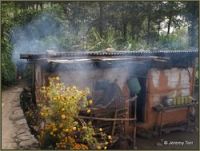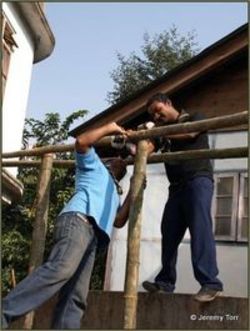Scouts from Singapore travel halfway round the world to help build a new, environmentally-sensitive classroom for remote village children in India’s West Sikkim. Text & photos by Jeremy Torr

Sikkimese villagers all we in remote, very basic housing. Extra money for school buildings is not option.
Sikkim, January 2011. Floods are in the news globally right now, but in the Indian Himalayan province of Sikkim, the clouds dump about 300 centimetres every year without fail. That’s a lot of water, and it regularly demolishes the roads. In the dry season, the roads barely cling to steep hillsides. During the monsoon, they usually lose the battle and end up in the bottom of the valley.
Which makes getting to school very difficult for Sikkim's young students, many of whom live in isolated communities on remote hillsides. Often, they simply can’t go to school as there is no road.
“We wanted our children to get a good education year round,” says Santabir Limboo, a village elder in Hee Bermiok, one of the tiny villages perched high above the Rangit River in West Sikkim. Santabir and the village elders solved the problem by setting up their own private school in a rented village house – and the local children came in droves, paying what they could.

Singapore Scouts went halfway round the world to build a new classroom - and did it the green way.
But the new school – the Pole Star English School - was so successful that it led to another problem: lack of space. There simply wasn’t enough room for so many keen seekers of knowledge. The villagers had the land, but didn’t have the manpower or the money to add any more classrooms for would-be students.
Co-incidentally, some Singapore Rover Scouts were looking for a challenge with a difference. One of them, Jeremy Chan, worked for award-winning Akitek Tenggara and had experience building environmentally sensitive structures out of local materials. He wanted to do something green, but useful. As chance would have it, Jayne Low, Singapore-based regional marketing manager for Jet Airways had just started looking at Sikkim as a tourist destination.
When Jayne, who had been talking with Sikkim-based tour operator Help Tourism, heard about the Hee Bermiok’s school – and the scouts - she realised she held the key to the problem. “I spoke to my boss and told him I thought we should help put the Scouts and the school people together,” she recalls, “and he said yes!”
Back in Singapore, Jeremy started drawing up plans for the extension. First they would need bamboo poles to support the roof, strong enough to cope with excitable schoolchildren. The poles had to be soaked in mountain streams for a few weeks to leach out the weak, pithy cores. The roofs would be sailcloth or corrugated iron, brought in on trucks when the roads were good. Crossbeams to help stabilise the structure would be made of local timber, screwed and lashed together.

After the classroom was built, the whole school gathered for a celebratory meal of local delights.
After arriving in Sikkim thanks to Jet Airways and Help Tourism, the scouts hammered, sawed, drilled, lashed and nailed for nine days. “We had to work with what we had,” remembers Jeremy. “When the electric drill stopped working we used a hand drill. It was that or we stopped work.”
The long-awaited classroom extension slowly emerged. Once the job was done; the teachers gave it the once-over. The verdict was positive; all the teachers, village elders and pupils gathered on a dry rice paddy and ate a celebratory meal of delicious rice and curry, finished off with play-acting. It was smiles all round.
“We established this school here so the children could learn, but just as important, learn in English all year round,” says Kabita Chhetri, one of the senior teachers at Pole Star. “In today’s world, the children need good English to gain skills.”
The Pole Star teachers don’t do it for the money, that’s for sure; they earn a lot less than their government school counterparts. “We do it through passion,” admits Kabita, who has an MBA as well as a teaching degree.
The extension was big enough for another 50 or so students to attend all year round, and was voted a big success by all. No more sharing seats and benches in a cramped room; the pupils would be able to enjoy an airy and spacious new learning environment that hadn't used up valuable Earth resources.
According to Kabita, pupils have already gone on from this remote community school to be doctors, engineers and other professionals. With the new classroom, even more will have the opportunity.
“Even some of the teachers at government schools send their children here!” smiles Santabir. So they must be doing it right.